- Home
- About
- Map
- Trips
- Bringing Boat West
- Migration West
- Solo Motorcycle Ride
- Final Family XC Trip
- Colorado Rockies
- Graduates' XC Trip
- Yosemite & Nevada
- Colorado & Utah
- Best of Utah
- Southern Loop
- Pacific Northwest
- Northern Loop
- Los Angeles to NYC
- East Coast Trips
- Martha's Vineyard
- 1 Week in Quebec
- Southeast Coast
- NH Backpacking
- Martha's Vineyard
- Canadian Maritimes
- Ocracoke Island
- Edisto Island
- First Landing '02
- Hunting Island '02
- Stowe in Winter
- Hunting Island '01
- Lake Placid
- Chesapeake
- Provincetown
- Hunting Island '00
- Acadia in Winter
- Boston Suburbs
- Niagara Falls
- First Landing '99
- Cape Hatteras
- West Coast Trips
- Burning Man
- Utah Off-Roading
- Maui
- Mojave 4WD Course
- Colorado River Rafting
- Bishop & Death Valley
- Kauai
- Yosemite Fall
- Utah Off-Road
- Lost Coast
- Yosemite Valley
- Arizona and New Mexico
- Pescadero & Capitola
- Bishop & Death Valley
- San Diego, Anza Borrego, Joshua Tree
- Carmel
- Death Valley in Fall
- Yosemite in the Fall
- Pacific Northwest
- Utah Off-Roading
- Southern CA Deserts
- Yosemite & Covid
- Lake Powell Covid
- Eastern Sierra & Covid
- Bishop & Death Valley
- Central & SE Oregon
- Mojave Road
- Eastern Sierra
- Trinity Alps
- Tuolumne Meadows
- Lake Powell Boating
- Eastern Sierra
- Yosemite Winter
- Hawaii
- 4WD Eastern Sierra
- 4WD Death Valley +
- Southern CA Deserts
- Christmas in Tahoe
- Yosemite & Pinnacles
- Totality
- Yosemite & Sierra
- Yosemite Christmas
- Yosemite, San Diego
- Yosemite & North CA
- Seattle to Sierra
- Southwest Deserts
- Yosemite & Sierra
- Pacific Northwest
- Yosemite & South CA
- Pacific Northwest
- Northern California
- Southern Alaska
- Vancouver Island
- International Trips
- Index
- Tips
- Books
- Photos/Videos
- Search
- Contact
Santa Cruz Island, Ecuador
Friday, March 24, 2023 - 9:30am by Lolo
0 miles and 0 hours from our last stop - 1 night stay
Travelogue
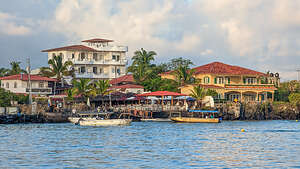 Cruising into Puerto Ayora on Santa CruzBright and early (as usual) we got on the pangas and cruised over to Puerto Ayora, an actual city with people in it, on Santa Cruz Island.
Cruising into Puerto Ayora on Santa CruzBright and early (as usual) we got on the pangas and cruised over to Puerto Ayora, an actual city with people in it, on Santa Cruz Island.
Santa Cruz Island is the center of Galapagos tourism. About half the island’s 18,000 residents live in or around the town of Puerto Ayora.
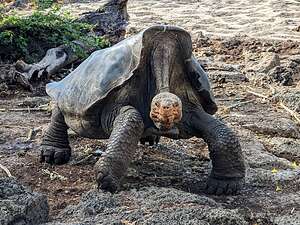 Giant Saddleback TortoiseI must say, it was a bit of a shock to see man-made structures, cars, and so many people again.
Giant Saddleback TortoiseI must say, it was a bit of a shock to see man-made structures, cars, and so many people again.
For the last 7 days, we had been as isolated from civilization as Charles Darwin and the crew of the Beagle had been in the 1830s - no interference from the outside world, no man-made anything - just us and the delightful wildlife in a quiet, pristine world.
I’m not sure I was ready for this.
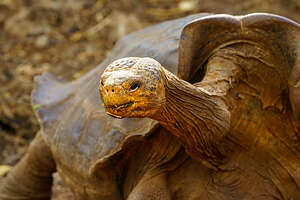 Giant Saddleback TortoiseWe spent the morning visiting the Charles Darwin Research Station, established in 1959 with the mission of the preservation and conservation of the plants and animals of the Galapagos Islands.
Giant Saddleback TortoiseWe spent the morning visiting the Charles Darwin Research Station, established in 1959 with the mission of the preservation and conservation of the plants and animals of the Galapagos Islands.
At the Visitor Center we saw “saddleback” tortoises, which are very different from the “domed” tortoises we saw a few days back on Isabela Island, or the ones we would see later today at the Rancho Primicias Giant Tortoise Reserve.
The domed tortoises have more rounded carapaces (shells), while the saddleback carapaces are flatter with an upward curve to the front, which allows them to stretch up to reach higher growing plants.
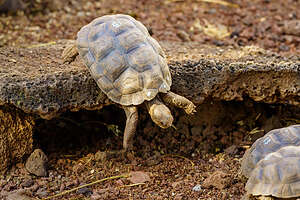 Hatchling being raised at the centerSaddlebacks tend to live on arid islands and feed mostly on cactus - that’s why they need those long necks, while the domed-shell tortoises live on more vegetated islands and feed primarily on grass.
Hatchling being raised at the centerSaddlebacks tend to live on arid islands and feed mostly on cactus - that’s why they need those long necks, while the domed-shell tortoises live on more vegetated islands and feed primarily on grass.
The Charles Darwin Research Station became quite famous in 1971 when it became the home to “Lonesome George,” the last remaining Pinta Island giant saddleback tortoise. Scientists and researchers rushed to find him a mate, but George simply was uninterested and no offspring were ever produced.
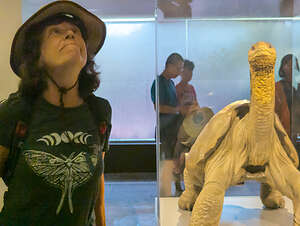 Lolo and Lonesome GeorgeSadly, in 2012 Lonesome George was found dead in his corral at the Tortoise Breeding and Rearing Center, marking the extinction of the Pinta species of tortoise.
Lolo and Lonesome GeorgeSadly, in 2012 Lonesome George was found dead in his corral at the Tortoise Breeding and Rearing Center, marking the extinction of the Pinta species of tortoise.
Because of his fame, George was frozen and shipped to the American Museum of Natural History in New York City to be preserved by taxidermists. Not sure when, but he has been returned to the Charles Darwin Research Center, where he has been placed in a specially designed building with a cooling system to preserve him.
As we solemnly stood before his taxidermied remains, I honored him by stretching my neck as far as I could. After all, imitation is the highest form of flattery,
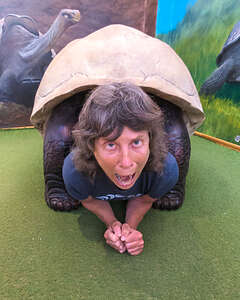 Lolo empathizing with a tortoiseOk, so if Pinta Island saddlebacks are extinct, what were we seeing wandering around the Breeding Center? Was this some kind of Jurassic Park? Well, maybe close. Based on much googling, I think scientists were able to find tortoises on other islands with DNA showing that they were hybrid Pinta tortoises. Maybe these guys are the offspring? - but don’t take my word on that.
Lolo empathizing with a tortoiseOk, so if Pinta Island saddlebacks are extinct, what were we seeing wandering around the Breeding Center? Was this some kind of Jurassic Park? Well, maybe close. Based on much googling, I think scientists were able to find tortoises on other islands with DNA showing that they were hybrid Pinta tortoises. Maybe these guys are the offspring? - but don’t take my word on that.
The Research Center also supports a program of collecting tortoise eggs from various islands where they have been threatened to extinction. The eggs are then incubated and hatchlings are raised for several years until they are ready to be reintroduced to their native Islands.
They all had numbers on their back, which I assumed identified which islands they came from so they could be re-introduced to the right place.
 Rancho Primicias Giant Tortoise ReserveMy favorite was #15, a feisty little fella with big dreams who wasn’t going to let a little ledge get between him and his buddy. I could almost hear him thinking, “I think I can, I think I can.”
Rancho Primicias Giant Tortoise ReserveMy favorite was #15, a feisty little fella with big dreams who wasn’t going to let a little ledge get between him and his buddy. I could almost hear him thinking, “I think I can, I think I can.”
Unfortunately, his dreams clashed with reality and the result was a face plant.
Our final activity at the Research Center was me, trying to empathize with the tortoise, by crawling inside a tortoise shell. Getting in was a lot easier than getting out.
Next we all piled in a van and drove us to the Rancho Primicias Giant Tortoise Reserve, located up in the Santa Cruz highlands, where we would be able to enjoy giant tortoises in their natural habitat.
While wandering the grounds, Tui started running towards some rather loud and weird moaning and groaning sounds in the distance. You can never go wrong following Tui, so several of us started running behind her. Unfortunately, Herb was nowhere to be found.
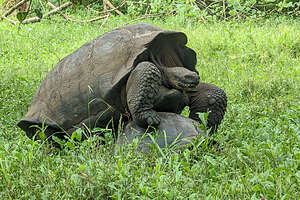 Mating Giant Domed TortoisesMarch is a great time to visit the Galapagos as it is the mating season, so there is lots of interesting action going on.
Mating Giant Domed TortoisesMarch is a great time to visit the Galapagos as it is the mating season, so there is lots of interesting action going on.
Sure enough, there was a male giant tortoise climbing on a much smaller tortoise, which was the female. We couldn’t even see her head. I think she might have had it tucked in. After more moaning and groaning, he rolled off her and walked away. What a romantic. I’m sorry Herb missed it.
After lunch at the Preserve, we returned to Puerto Ayora and were set loose to explore on our own.
 Herb enjoying the Santa Cruz BreweryWe’re not big shoppers, but we do like to come home with something to remember our trip by. We knew exactly what we wanted - a little blue-footed booty, hand-carved out of cedar wood, which we bought at a wood-carver’s studio called Hera’s Art Gallery.
Herb enjoying the Santa Cruz BreweryWe’re not big shoppers, but we do like to come home with something to remember our trip by. We knew exactly what we wanted - a little blue-footed booty, hand-carved out of cedar wood, which we bought at a wood-carver’s studio called Hera’s Art Gallery.
Civilization isn’t all bad. We spent the remainder of our free time in Puerto Ayora enjoying a beer (or two) and the Santa Cruz Brewery, sitting on the balcony watching the activity in the harbor. It started to rain really hard (our second and final rain of the trip), but fortunately, we were covered and cozy.
Okay, now let’s get back to our critter-only, pristine little world on the Tip Top IV.
Recap of wildlife we saw today: Humans, Galapagos Giant Saddleback tortoises, and Galapagos Giant Domed Tortoises
- ‹ previous
- 10 of 13
- next ›
Santa Cruz Island location map in "high definition"
Javascript is required to view this map.
